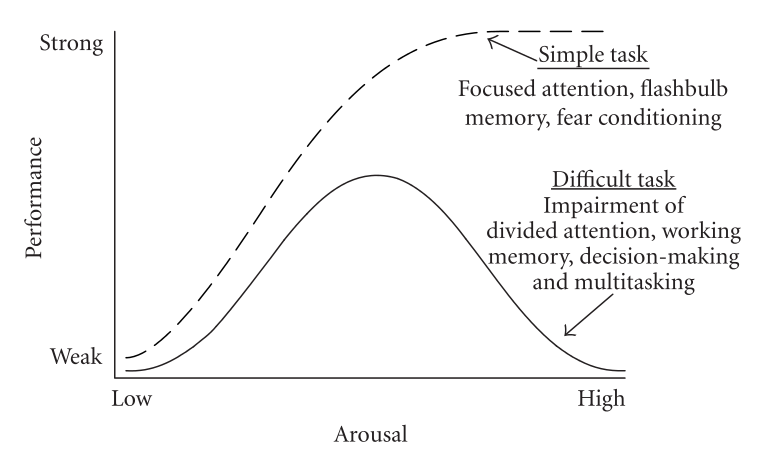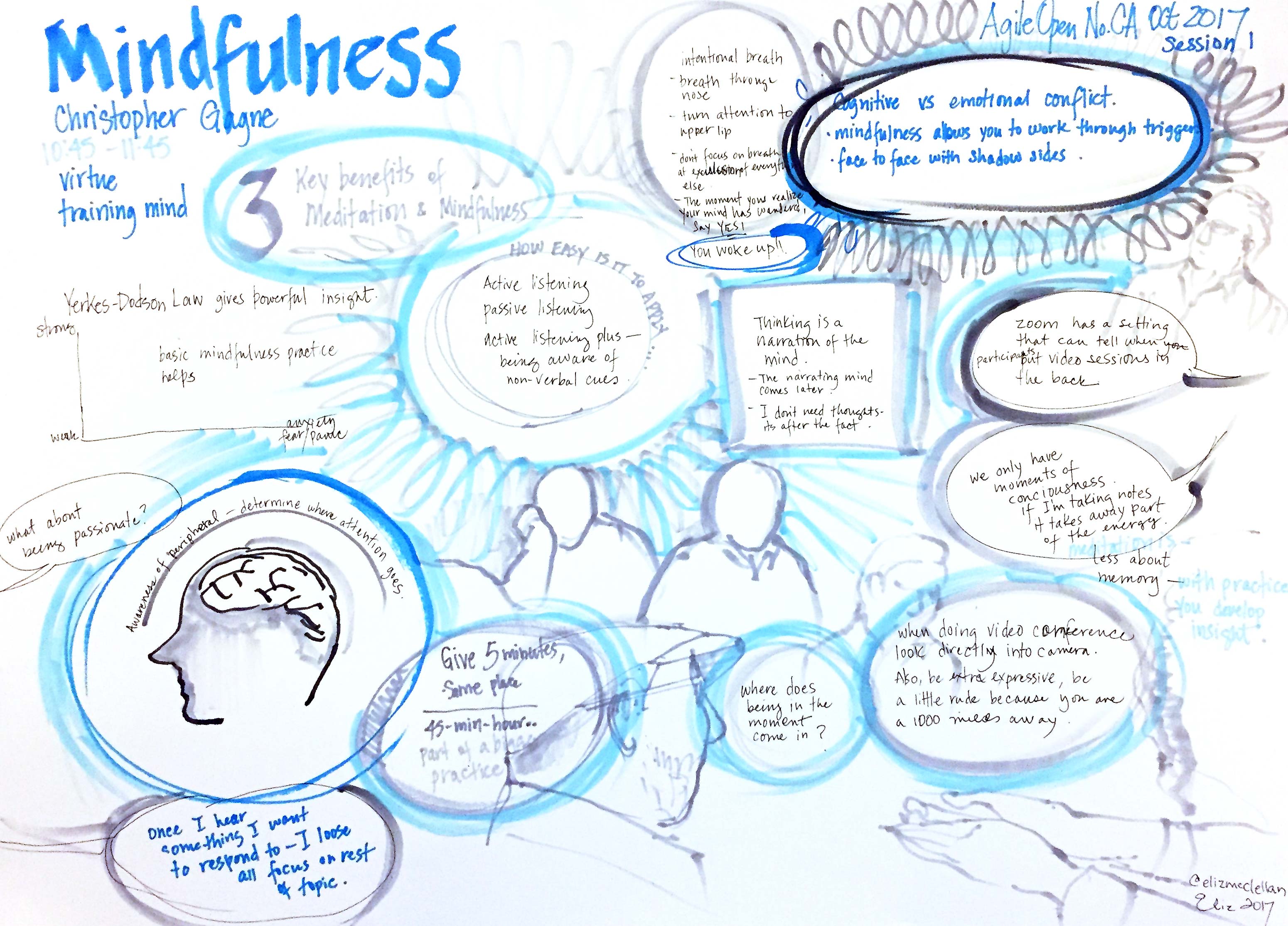As an Agile coach and meditation teacher-in-training, I regularly spot opportunities where Agile and mindfulness are aligned. Here’s a summary of the three key benefits of meditation and mindfulness in knowledge work environments that routinely come to mind for me. I’ve given this as a talk at Agile Open Northern California 2017 and I’d be delighted to share it elsewhere as well.
Benefit 1: Higher performance due to more effective stress management
The Yerkes-Dodson Law gives us a powerful insight. Our culture’s dominant management philosophy of associating increased physiological arousal (stress, anxiety, even panic) with greater performance is perfectly suited to the simple tasks (agriculture, construction, etc) that to this day make up a majority of human labor. Thus, we should not be surprised that many managers rely on it. However, research shows that for difficult tasks—our modern knowledge work—increased arousal compromises performance beyond a point. Further, the more difficult the work, the less arousal is optimal:

The only truly durable solution is improving our leadership approach. Meditation is a crucial tool for leaders who are willing to embark on a challenging, life-long quest of personal-social development.
For those doing the work, meditation is a powerful means for reducing stress once it has arisen. Long-term, meditation can reduce and even eliminate the conditioning that gives rise to anxiety or panic, thus assuring stronger performance.
Benefit 2: An optimal balance of attention and awareness is required to listen well
You may be familiar with the “3 levels of listening:”
- Internal Listening: “I’m ‘listening’ to you, but I’m mostly thinking of what I’m going to say next and paying attention to what’s going on internally in me…”
- Focused Listening: “I’m listening to you with 100% of my attention, not only hearing your words but also fully-attuned to your non-verbal communication and emotions.”
- Global Listening: Similar to Level 2, but with a profound awareness of the full context in which the conversation takes place.
Unfortunately, it is difficult for many to listen at either level 2 or 3, regardless of how much we intend to do so. Our strong egoic sense of self keeps bringing us back to our inner universe.
As Dr. John Yates describes in his book The Mind Illuminated, our minds operate with both attention (similar to focused vision) and awareness (similar to peripheral vision) simultaneously. Our society overemphasizes attention at the expense of awareness. It is as if we have a powerful spotlight, but its illumination is too narrow for us to know that it is pointing in the wrong direction.
A correct and disciplined practice rapidly develops strong introspective and extrospective awareness, bringing attention and awareness in balance. In a matter of only months or a few years at most, we can develop a continual awareness of where our attention is placed. This allows us to direct our attention as intended and hold it there indefinitely.
Benefit 3: Meditation improves our ability to engage in constructive conflict
The Conflict Dynamics Model describes conflict as being either constructive (cognitive) or destructive (emotional) and either active or passive. For instance, constructive active conflict might entail seeking to understand everyone’s perspectives, whereas destructive passive conflict might entail avoiding a crucial conversation.
Our ability to remain in cognitive conflict with others relies predominantly on our emotional self-regulation. A growing body of research provides strong evidence that a regular meditation dramatically improves our ability to manage our emotions. In fact, a 2013 study shows that just eight weeks of meditation reduces the size of the amygdala (the brain’s flight-or-flight center) and increases the thickness of the pre-frontal cortex (involved in self-regulation, awareness, and decision-making concentration).
Thus, meditation helps prevent us from winding up in a “flight or fight” or “amygdala hijack” mode when we are in conflict with others by improving our ability to manage our strong emotions when they arise. Better yet, a diligent meditation practice can bring us deep into our psyches and defuse the “ticking time bombs” of our conditioning (due to past traumas, etc).
Here is a set of initial mediation instructions that you may find useful for exploring the above. Contact me if you’d like any assistance!
Here’s a tidy, printable version of this article. The article text is licensed under a Creative Commons Attribution-ShareAlike 4.0 International license, so please feel free to print and share with others (even commercially). This image (not under the CC license) was drawn by Elizabeth McClellan at Agile Open 2017. You should hire her! 🙂

Great post! It’s interesting to see discussion of meditation and productivity together. I’ve definitely noticed since I started meditation (after reading The Mind Illuminated) that I could perform better during stressful work situations.
Do you think meditation has any negative effect on knowledge work? For example, maybe diminished ambition?
Hi Oliver! Yes, I think it’s entirely possible that meditation could decrease some kinds of ambition. I think a lot of ambition is driven by craving. Meditation can really cut at the root of that craving, so that can cause a drop in desire to pursue what we once thought was so important.
It’s important that we replace selfish craving with wholesome desires. Otherwise we may not have as much sense of purpose and experience a growing ennui. Liberation from individual suffering comes with profound compassion towards universal suffering because you discover your radical interdependence with all of existence in the process. So there is never really a moment where we get to check out and sit peacefully on a mountain once we’ve gotten the insight. I’d say “volunteers wanted,” but you don’t have much choice in the matter… 😉
That makes sense. Did you personally have major changes to your goals/ambitions as a result of meditation?